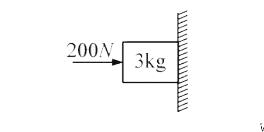A bus turns a slippery road having coefficient of friction of 0⋅5 with a speed of 10 m/s .The minimum radius of the arc in which bus turns is [ Take g = 10 ms2]
4m
10m
15m
20m
The correct Answer is:D
To find the minimum radius of the arc in which the bus turns on a slippery road, we can use the concepts of centripetal force and friction. Here’s a step-by-step solution:
Step 1: Identify the given values
- Coefficient of friction (μ) = 0.5
- Speed of the bus (v) = 10 m/s
- Acceleration due to gravity (g) = 10 m/s²
Step 2: Write the expression for the force of friction
The force of friction (F_friction) that provides the necessary centripetal force for the bus to turn is given by:
Ffriction=μ⋅N
where N is the normal force. For a bus on a flat road, the normal force (N) is equal to the weight of the bus (mg):
Ffriction=μ⋅mg
Step 3: Write the expression for centripetal force
The centripetal force (F_c) required to keep the bus moving in a circular path is given by:
Fc=mv2r
where m is the mass of the bus, v is the speed, and r is the radius of the arc.
Step 4: Set the forces equal to each other
For the bus to turn without slipping, the frictional force must equal the centripetal force:
μ⋅mg=mv2r
Step 5: Cancel out the mass (m)
Since the mass (m) appears on both sides of the equation, we can cancel it out:
μg=v2r
Step 6: Rearrange the equation to solve for r
Rearranging the equation to find the radius (r):
r=v2μg
Step 7: Substitute the known values
Now, substitute the known values into the equation:
- v = 10 m/s
- μ = 0.5
- g = 10 m/s²
Thus,
r=(10)20.5⋅10
r=1005
r=20meters
Final Answer
The minimum radius of the arc in which the bus turns is 20 meters.
---
- Coefficient of friction (μ) = 0.5
- Speed of the bus (v) = 10 m/s
- Acceleration due to gravity (g) = 10 m/s²
The force of friction (F_friction) that provides the necessary centripetal force for the bus to turn is given by:
Ffriction=μ⋅N
where N is the normal force. For a bus on a flat road, the normal force (N) is equal to the weight of the bus (mg):
Ffriction=μ⋅mg
The centripetal force (F_c) required to keep the bus moving in a circular path is given by:
Fc=mv2r
where m is the mass of the bus, v is the speed, and r is the radius of the arc.
For the bus to turn without slipping, the frictional force must equal the centripetal force:
μ⋅mg=mv2r
Since the mass (m) appears on both sides of the equation, we can cancel it out:
μg=v2r
Rearranging the equation to find the radius (r):
r=v2μg
Now, substitute the known values into the equation:
- v = 10 m/s
- μ = 0.5
- g = 10 m/s²
r=(10)20.5⋅10
r=1005
r=20meters
The minimum radius of the arc in which the bus turns is 20 meters.
Topper's Solved these Questions
- LAWS OF MOTIONBook:AAKASH INSTITUTE ENGLISHChapter:LAWS OF MOTIONExercise:ASSIGNMENT ( SECTION -B) objective type questions (one option is correct)
Explore 59 Videos
- LAWS OF MOTIONBook:AAKASH INSTITUTE ENGLISHChapter:LAWS OF MOTIONExercise:ASSIGNMENT ( SECTION -C) objective type questions (More than one options are correct)
Explore 21 Videos
- LAWS OF MOTIONBook:AAKASH INSTITUTE ENGLISHChapter:LAWS OF MOTIONExercise:TRY YOURSELF
Explore 69 Videos
- KINETIC THEORYBook:AAKASH INSTITUTE ENGLISHChapter:KINETIC THEORYExercise:EXERCISE (ASSIGNMENT) SECTION - D Assertion - Reason Type Questions
Explore 10 Videos
- MAGNETISM AND MATTER Book:AAKASH INSTITUTE ENGLISHChapter:MAGNETISM AND MATTER Exercise:ASSIGNMENT (SECTION D)
Explore 26 Videos
Similar Questions
A car turns a corner on a slippery road at a constant speed of 10 m /s . If the coefficient of friction is 0.5, the minimum radius of the arc in meter in which the car turns is
View SolutionA ball is thrown up at a speed of 4.0 m/s. Find the maximum height reached by the ball. Take g=10m/s2.
View Solution
Knowledge Check
The mass of a bicycle rider along with the bicycle is 100 kg. he wants to cross over a circular turn of radius 100 m with a speed of 10ms−1. If the coefficient of friction between the tyres and the road is 0.6, will the rider be able to cross the turn? Take g=10ms−2.
A300NB600NC1200ND150N
A car is moving on a horizontal circular track of radius 0.2 km with a constant speed. If coefficient of friction between tyres of car and road is 0.45, then maximum speed of car may be [Take g=10m/s2]
View SolutionA ball is projected vertically up with speed 20 m/s. Take g=10m/s2
View SolutionA pebble is thrown vertically upwards with a speed of 20 m s−1. How high will it be after 2 s? (Take g = 10 m s−2)
View SolutionA car is travelling at 36 kmph on a road. If μ=0.5 between the tyres and the road, the minimum turning radius of the car is: (g=10ms−2)
View SolutionYou throw a ball straight up with an initial speed of 10 m/s. Take upward direction as + Y axis and g=10m/s2 :-
View SolutionConsider, a car moving along a straight horizontal road with a speed of 72 km/h. If the coefficient of static friction between the tyre and the road is 0.5, the shortest distance in which the car can be stopped is (Take g=10/s2)
View SolutionA force of 200N is applied as shown in the figure on block of 3 kg. The coefficient of friction between the block and the wall is 0.3. Find the friction acting on the block. (in N) {Take g = 10 m/s2

View Solution
